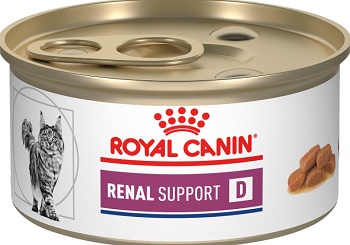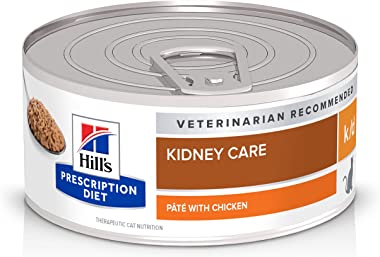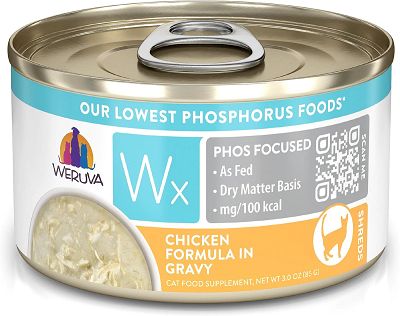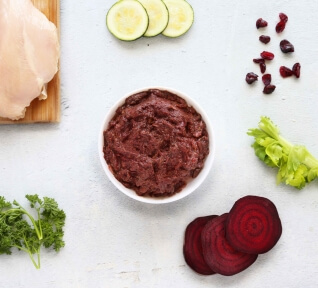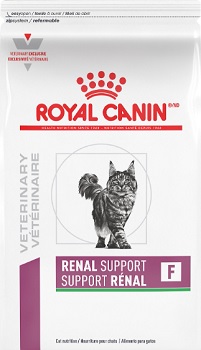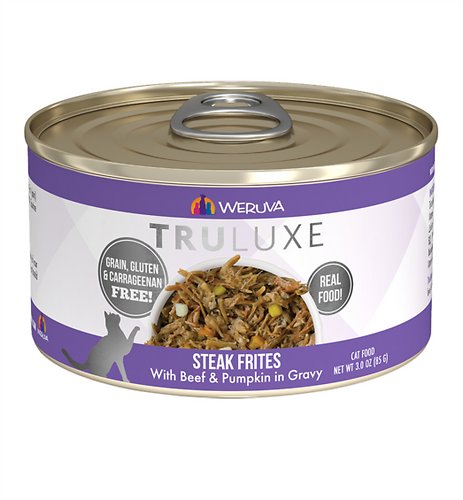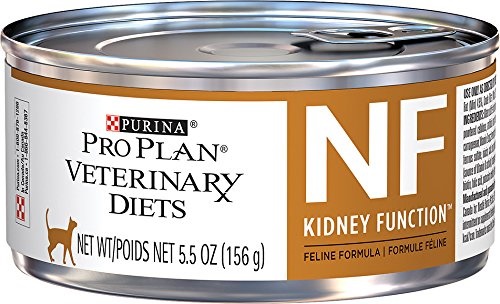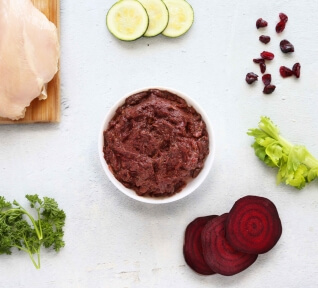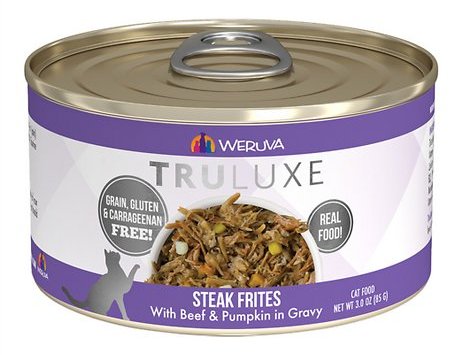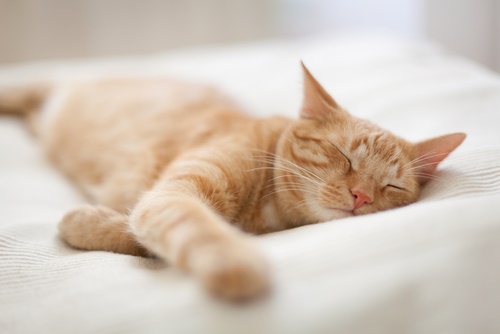
Dietary management can’t turn back the clock on kidney disease, but it can make the future brighter. Feeding your cat the right food is the best way to slow the disease’s progression, minimize symptoms, and give your cat the best life possible.
We recommend Royal Canin Veterinary Diet Renal Support D Morsels in Gravy as the overall best cat food for kidney disease because it’s low in phosphorus with controlled sodium, added B vitamins, and anti-inflammatory omega-3s. No diet is perfect, but this product has a strong reputation for helping cats with chronic kidney disease (CKD).
At a Glance: Best Food To Buy for Cats With Kidney Disease




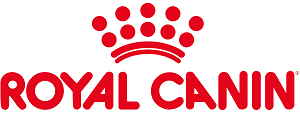
Royal Canin Veterinary Diet Renal Support D Morsels in Gravy Canned Cat Food
- Maximized energy density to help keep cats strong and muscular
- Contains omega-3 fatty acids to reduce inflammation
- Low phosphorus levels help your cat to feel better

Hill’s Prescription Diet k/d Kidney Care with Chicken Canned Cat Food
- Controlled phosphorus levels
- Added omega-3 fatty acids for anti-inflammatory effect
- Calorie-dense to support muscle mass
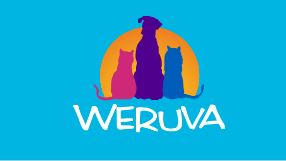
Weruva Wx Phos Focused Chicken Formula in Gravy Grain-Free Wet Food
- Contains more than 50% protein on a dry matter basis
- Made with lean animal-based protein from chicken and egg white
- Contains up to 50% less phosphorus than AAFCO minimums
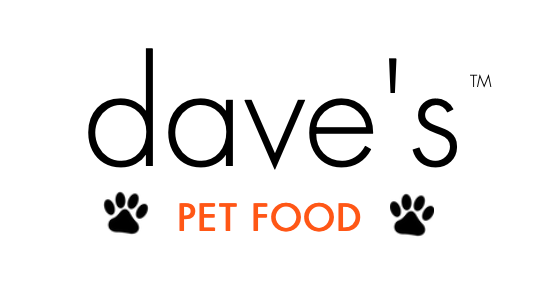
Dave’s Pet Food Chicken Liver and Chicken in Juice Pate Recipe Restricted Phosphorus Canned Food
- Top three ingredients are animal-based
- Rich in hydrating moisture to support renal function
- Made with a single source of animal protein

Darwin’s Natural Intelligent Design™ KS Kidney Support Raw Cat Food
- Restricted phosphorus content
- Added omega-3 fatty acids
- Elevated levels of B-complex vitamins

Royal Canin Veterinary Diet Renal Support F Dry Cat Food
- Omega-3 fatty acids from fish oil help reduce inflammation
- Controlled phosphorus helps your cat feel healthier
- Customers report that the square kibble is easy for their senior cats to eat

Weruva TruLuxe Grain-Free Steak Frites with Beef & Pumpkin in Gravy
- Low in phosphorus, which might help to prevent and ease the symptoms of kidney disease
- Rich in easily-utilized animal protein
- Low carbohydrate content

Purina Pro Plan Veterinary Diets NF Kidney Function Advanced Care
- Low in phosphorus
- Highly palatable
- Calorie dense to support lean body mass
Why Trust Cats.com
Before selecting products for testing, we dug deep into the subject of dietary management of kidney disease in cats. We reviewed scientific studies, vet interviews, and other resources to determine what qualities make a cat food product appropriate for cats with kidney disease. Finally, we consulted our own panel of veterinary experts for advice.
With this expert guidance, we selected a handful of products for in-depth evaluation. We spent hours analyzing labels, reading customer reviews, and communicating with the manufacturer directly to determine each product’s dry matter phosphorus content. The products featured here were purchased at full retail price and personally tested by members of our team with their own cats at home.
Chronic Kidney Disease in Cats Explained
This article is not a substitute for veterinary advice. Your veterinarian can provide personalized suggestions relevant to your cat’s unique situation.
What To Look For in Cat Food for Kidney Disease
Years of scientific research and experience have left cat owners, seasoned veterinarians, and scientists with more questions than answers regarding chronic kidney disease (CKD).
This article can’t give you all the answers to the feline CKD puzzle, but it will help you understand the complex dynamics between diet and disease. You should walk away from this article feeling less overwhelmed and more confident about your ability to make the right choices for your cat.
You’ll find out why food matters, learn what goes into a great diet, and read reviews of the best foods for cats with kidney disease. Let’s start with the key principles of feeding a cat with CKD.
Monitoring the progression of your cat’s kidney disease is essential, even if you make dietary changes. Kidney-Chek, an at-home saliva test, can help you keep tabs on your cat’s kidney function. Learn more about Kidney-Chek here.
Protein and CKD
When dietary protein breaks down during digestion, it produces waste. One of these waste products is urea. Healthy kidneys filter out this waste and send it on its way into the litter box.
But as your cat loses kidney function, it becomes increasingly difficult to remove these waste products. Instead of passing through your cat’s body, waste products remain in the bloodstream. This is why blood urea nitrogen (BUN) levels rise in cats with CKD. BUN is a measurement that veterinarians analyze on routine bloodwork to evaluate kidney health.
In an attempt to reduce BUN levels, cats with CKD are often given protein-restricted foods. But in recent years, this practice has become increasingly controversial.
Experts worry that a protein-restricted diet will lead to severe protein deprivation, decreased muscle mass, and poor physical condition. Instead of cutting back to 20% or fewer calories from protein, you might choose to feed moderate levels of highly digestible, low-waste protein from high-quality animal sources.
The bottom line is that you want your cat to feel better, not worse. Although a protein-restricted diet helps some cats feel better, it might also lead to muscle wasting and weakness. Talk to your veterinarian about the costs and benefits of a low-protein diet for your cat.
Phosphorus Content Less Than 0.5%
As kidney function declines, phosphorus is one of the things that doesn’t get filtered out. As phosphorus builds up in the bloodstream, your cat will start to feel ill and kidney function declines even more quickly.
The best way to counteract this effect is to reduce the amount of phosphorus in your cat’s diet. The ideal diet for a cat with CKD contains less than 0.5% phosphorus on a dry matter basis.
Relatively Low Sodium Content
Because excessive sodium consumption can increase blood pressure and worsen kidney damage, most renal (kidney) diets are low in sodium. You’ll also want to avoid any high-sodium treats like lunch meat and salty cheese.
Anti-Inflammatory Omega-3 Fatty Acids
Many cats with kidney disease develop nephritis, which is inflammation of the kidneys. Along with other anti-inflammatory supplements, consider omega-3 fatty acids like EPA and DHA. These fatty acids have a well-documented ability to reduce inflammation, helping your cat to feel better.
Although humans and other animals can benefit from omega-3 fatty acids derived from plant sources like flaxseed oil, cats can only utilize those found in animal fat. Good sources include various types of fish oil—like salmon oil, menhaden fish oil, and sardine oil—as well as krill oil. You can also consider green-lipped mussels. In addition to being a good source of other omega-3s, they’re the ocean’s most concentrated source of the fatty acid EPA.
Although many foods contain sources of these beneficial fatty acids, you might also want to supplement your cat’s diet with a good omega-3 supplement.
Supplementation With B Vitamins
Because cats with kidney disease urinate so much, they often lose crucial B vitamins in the litter box. Deficiency in B vitamins is associated with loss of appetite and overall poor health.
Prescription or therapeutic diets for kidney disease are usually fortified with additional B-complex vitamins. Your veterinarian might also recommend B12 shots to give your cat a boost.
In addition to vitamins in your cat’s diet and subcutaneous injections, consider giving your cat a multivitamin supplement like Vetoquinol Renal K+. Formulated for cats and dogs with kidney disease, this gel contains B-complex vitamins and potassium. Both substances support muscle function and your cat’s nervous system health.
High Moisture Content
Kidney disease causes cats to urinate excessively and lose their appetites, so dehydration is common among cats with the condition. Many cats rely on subcutaneous fluid injections (injections under the skin) to stay hydrated, but there’s more than one way to increase your cat’s water intake.
Wet food is 70% water or more, making it an effortless source of the hydration your cat needs. If you’re currently feeding a dry diet, switching to wet food might give your cat an additional four ounces of water each day. That’s as much or more than they’d get in a typical fluid injection.
Your cat might still need additional subcutaneous fluids, but feeding a juicy diet will significantly reduce your cat’s risk of severe dehydration.
Should You Feed Your Cat Prescription Food for Kidney Disease?
Currently, prescription or therapeutic diets are the only foods that check all the boxes from the previous section.
Frustratingly, those diets often have other not-so-great qualities like high carbohydrate content, added sugar, and potentially low-quality animal by-products.
You can hold your nose over the ugly parts of a therapeutic or prescription diet. You can opt for non-prescription food that meets one or two of the above criteria. Or you can make CKD-appropriate food at home.
By doing it yourself, you can provide the nutrition your CKD cat needs while being able to choose the types of ingredients you prefer. But you’re also taking a risk—homemade food takes time to prepare, and it can be hard to get everything right. If you’re going to make homemade cat food for kidney disease, always work with a veterinary nutritionist or your veterinarian to ensure the recipe is appropriate.
For more information, check out our guide to creating a raw diet for your cat with kidney disease.
The 8 Best Foods for Cats With Kidney Disease
Prescription or therapeutic diets earn the top spots on our list of recommendations because they offer a combination of renal disease-appropriate qualities that you won’t find in any other commercial food.
If prescription food isn’t within your budget—or if your cat is in the early stages of kidney disease—a non-prescription product might suit your needs. You’ll find several options on this list.
Above All, Cats With Chronic Kidney Disease Need To Eat
From Dr. David J. Polzin, DVM, Ph.D., DACVIM’s 11 Guidelines for Conservatively Treating Chronic Kidney Disease: “In many or most dogs and cats with chronic kidney disease, death or euthanasia results directly or indirectly from starvation.”
The dietary recommendations above apply only to cats that are still eating. But if the disease has progressed to a point where your cat is no longer interested in food, nutritional rules go out of the window. If your cat is refusing to eat, don’t worry about feeding a therapeutic diet. Any food they’re willing to eat is good food.
Consider Giving Your Cat High-Calorie Supplements
In addition to traditional food, talk to your veterinarian about giving your cat high-calorie supplements. High-calorie gels and treats help to curb weight loss and keep your cat feeling as well as possible. Consider nutritional gels like Tomlyn Nutri-Ca and Vetoquinol Nutri-Cal.
Food toppers, broths, and treats can also help. Some cats, especially those with poor dental health, might be willing to eat baby food.
You Might Also Consider Supplementing Your Cat’s Diet With a Probiotic
When bacteria and endotoxins enter the gut, probiotics might help to perform “enteric dialysis,” taking on some of the detoxifying function that the kidneys have lost.
Azodyl is a synergized prebiotic and probiotic supplement designed for cats with kidney disease. The supplement contains patented strains of Enterococcus thermophilus, Bifidobacterium longum, and Lactobacillus acidophilus. The three probiotics are synergized with psyllium husk, a source of prebiotic fiber.
While it’s not clear that Azodyl will help, it does show some promise. If you’re not willing to spend more than $70 a bottle for the putative benefits of Azodyl, consider supplementing with another probiotic.
Talk to your veterinarian before giving your cat any supplements, including probiotics. Your vet can help you determine which supplements could help your cat and instruct you on how to give them.
Read Our Guide To The Best Probiotics On The Market
Here Are a Few Additional Resources To Help You Out
These resources might help you learn more about feline kidney disease and decide which foods are right for your cat.
FelineCRF.org
Also known as Tanya’s Comprehensive Guide to Feline Chronic Kidney Disease, this site is an extraordinary free resource for pet owners. Though not written by a veterinarian, the site’s informative content has been endorsed by vets and veterinary specialists. The massive site contains more than 1,000 pages of information and covers almost everything you need to know about this disease and its treatment.
If you prefer, you can also buy the paperback version of the site. The 630-page book is available on Amazon at around $39.99.
Cat Food Database
As your cat’s kidney disease progresses, you’ll probably have to pry out their appetite with a variety of foods. The following databases might help you to evaluate your options based on CKD-relevant metrics.
An Interview with Dr. Lisa Pierson
In this 34-minute interview, well-known veterinarians Dr. Karen Becker and Dr. Lisa Pierson explore the causes and treatment of kidney disease in cats. Pierson’s common-sense approach is a calm in the storm of confusion that is CKD.
Frequently Asked Questions
What foods are good for cats with kidney disease?
Cats with chronic kidney disease (CKD) benefit from foods that have controlled levels of protein, and are low in phosphorus and sodium. B-complex vitamins can help to break down nutrients to help your cat feel better, and omega-3 fatty acids have an anti-inflammatory effect, which can help cats with kidney disease. A high-moisture food (a wet food) is best to provide hydration cats with kidney disease need.
How can I slow down my cat’s kidney failure?
Dietary modification—feeding a diet that’s helpful for cats with chronic kidney disease—can help slow disease progression. Cats with kidney disease also need support resolving or preventing dehydration, often via subcutaneous fluid administration. Your veterinarian might also recommend certain supplements or medications to support your cat’s individual health needs.
What not to feed a cat with kidney disease?
Cats with kidney disease should not eat foods that are high in phosphorous or sodium. High-protein diets are also not good for cats with kidney disease. Protein should be controlled so that it is not too low and not too high. A canned wet diet is preferably to a dry diet to help keep your cat hydrated. Talk to your veterinarian about the most appropriate diet to feed your cat with kidney disease.
What makes kidney disease worse in cats?
Inappropriate diet, excessive levels of salt or phosphates, dehydration, low potassium levels, hypertension, and anemia can make kidney disease worse.
